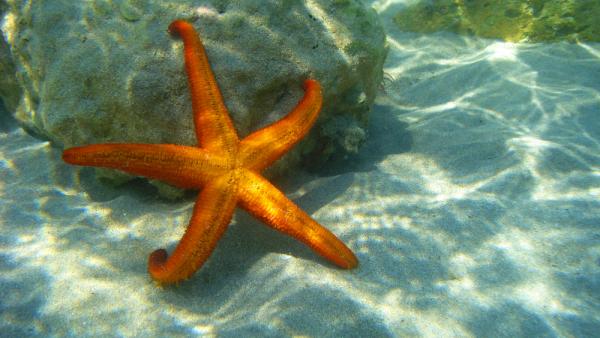As if the starfish itself wasn't beautiful enough, now we have new research revealing the beauty and wonderous efficiency of how this fascinating, five-pointed creature survives and grows in the sea.
Driven by the curiosity surrounding its very early stages of life, a team of researchers from Stanford's Hopkins Marine Station in Pacific Grove, California decided to study why the starfish's larvae look the way they do, as well as how they're able to survive and grow into adulthood. Among its research, the team "studied the organisms in a systematic way, feeding the larvae nutrient algae and observing their movements with video-enabled microscopes," according to a release this week from the Stanford School of Engineering.
What the team discovered was pretty fascinating. Specifically, the larvae – each not even the size of a grain of rice – use lashes (think: tiny oars) to create swirls of water around itself. These tiny whirlpools serve three primary purposes. One, propulsion, to find better food sources and escape predators; two, suction, bringing nearby food closer to ingest; and three, strength accumulation, a means by which to grow.
 "Our first eureka moment came when we saw the complex vortices flowing around these animals," said Vivek Prakash in a statement, a postdoctoral scholar in bioengineering and team member, referring to the image at right (courtesy of Stanford University). "This was beautiful, unexpected and got all of us hooked. We wanted to find out how and why these animals made these complex flows."
"Our first eureka moment came when we saw the complex vortices flowing around these animals," said Vivek Prakash in a statement, a postdoctoral scholar in bioengineering and team member, referring to the image at right (courtesy of Stanford University). "This was beautiful, unexpected and got all of us hooked. We wanted to find out how and why these animals made these complex flows."
The study's paper, titled "Starfish larvae create complex water whorls to eat and run," and published online in Nature Physics, highlights the workings of these oars, called cilia, which number roughly 100,000 for each larvae. Using these rows of cilia, each organism undergoes a two-month metamorphosis, eating, swimming and growing until it reaches the common shape we're accustomed to seeing.
"[T]he cilia had three potential actions: forward, reverse and stop. And just as with oars, the cilia moved in different synchronized patterns to create different motions. Presumably orchestrated by its nervous system, the larva beats its 100,000 eyelashes in certain patterns when it wants to feed, so as to swirl the water in a way that brings algae close enough to grab. Then, with a different flutter of eyelashes, the larva creates a new pattern of whorls and speeds off."
If you're looking to delve a little deeper into this striking topic, here's an interesting video produced by Stanford.
It's also worth noting that since the starfish is not actually a fish at all (no gills, fins or scales), marine biologists are trying to get the public to refer to it as a "Sea Star." But since the five-sided creature – which has an average life span in the wild of 35 years – is so beloved, that's proving to be a tough sell.
Another fact frequently overlooked is that it can have more than five sides, or arms, and still be a starfish. Some have 10, 20 or even 40 arms. And, lastly, according to National Geographic, starfish only exist in salt water. "Purely marine animals, there are no freshwater sea stars, and only a few live in brackish water."
Source: William Gilpin, Vivek N. Prakash, and Manu Prakash. "Vortex arrays and ciliary tangles underlie the feeding–swimming trade-off in starfish larvae." Nature Physics. Published: 19-December-2016. doi: 10.1038/nphys3981




